Monthly Diary 2021
Monthly Diary 2021
December 2021
With the weather being so dreary these last few weeks, I really didn't think I would see that much on the Green for the December post - but how wrong I was! Fox (sorry I wasn't quick enough to get a photo), little egret, snipe, redwing, heron, green woodpecker, goldfinch, mistle thrush, plus others were all out and about looking for food. It was fantastic and just goes to show that whatever the weather, there is always something to see in nature! I did manage to get a photo of a lovely redwing and you can clearly see the red patch by the wing (and hence its name!). It is a winter visitor and a member of the thrush family and definitely one to look out for at this time of the year.
Whilst wandering around the Green, I came across this delightful clump of mushrooms hiding amongst some of the rush. I don't know which species they are, but I love the way the ice crystals are decorating the top of the cap.
Who can't resit a robin, to get into the festive mood? This little one had certainly spotted something to eat on the ground! Some of you, reading this post, may realise that the format and layout of the post has changed and this is because we have a new website! I will be promoting this in the New Year, but in the meantime please have a look around and hopefully enjoy some of the new content.
And finally, the Trust would like to wish everyone Happy festive season! Hopefully many of you will have enjoyed your time spent on the Green this year and we hope that you will continue to support us in 2022.
November 2021
Some of our regular visitors may have noticed some weird yellow/white "things" appearing amongst the grass on the Green. This is Mucilago crustacea, or more aptly known as dog sick (or vomit) slime mould (although to be perfectly honest, I have never had my dog sick up something that looks like this!) The slime mould is not a fungus, but a single celled organism, which normally lives in the ground. However, when the conditions are right, the cells clump together, move above ground and form these weird slimy structures (See insert for a close up - most odd!) These in turn germinate to produce spores, ready for the next generation of slime moulds - fascinating stuff!
Carrying on with the weird theme, we have also had some more spindle fungi appear. These are white spindles (Clavaria fragilis) and it is the first time I have seen them on the Green, which is great news! They can be found where the grass is quite short and where there is a good moss layer. However, you do have to look carefully, as they are quite easy to miss!
The Autumn colours have been stunning this month and I love this view of the cathedral bathed in afternoon sunlight against a dark sky, with all the oranges and yellows of the trees and hedges in the foreground.
On another note, this is the last time that I will be posting the monthly diary, on this website. Do not despair though, as we will be launching a new (and hopefully better)revamped website in December, which will include a new monthly diary page as well!
October 2021
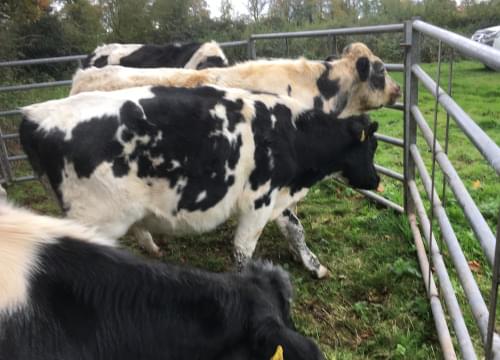
You may have noticed that the cattle were taken off the Green at the end of October, having done an exceptional job this year. As mentioned previously, cattle are an important part of the management of the Green, grazing not only the meadow area, but also in the wetter part of the Green, where they do a fantastic job in trampling the rush and breaking up the ground.
For me October is always the month of fungi, and this year is no exception! The Green is fortunate to have a number of rare waxcap fungi, which require, low nutrient levels, short grass and a well-developed moss layer - something the Green has to offer. However, unfortunately it is not all good news, as waxcap numbers have decreased markedly in some places this year. This is due to more people walking on the Green, creating new paths across the meadow, which in turn tramples the ground and destroys the waxcap’s precious habitat. So please try to walk on the edge of the Green and protect this fragile meadowland habitat! Below is a collection of some of the lovely waxcaps and fairy clubs that you might see - I think you will agree, they are rather special and worth looking after!
September 2021
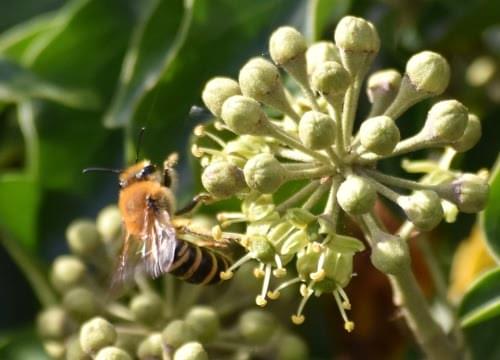
I was thrilled last week to finally get to see an ivy bee on Pipe Green! I have been on the lookout for this bee over the last couple of years and so it was brilliant to finally get to see some. As the name suggests they feed on the very sweet smelling ivy flowers, which are now flowering. The ivy bush by the football field gate is a good place to stop and look for them (as well as loads of hover flies and other buzzy things!) The ivy bee was first identified in the south of the UK twenty years ago and they are slowly making their way north. So it is good to know that they have made it to Staffordshire.
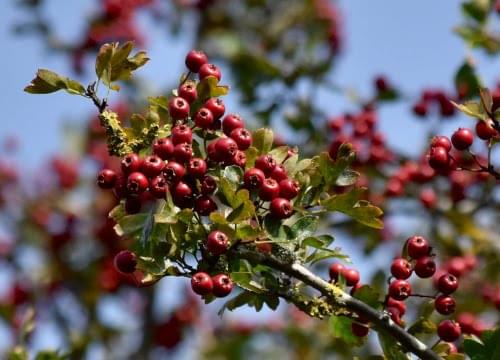
It only seems like yesterday that the hawthorn was in blossom, but now we have the gorgeous red haws gleaming in the sunshine, showing that Autumn is now here. The berries are an important food source in the colder months for some of the birds (blackbirds, thrushes, redwing, fieldfare) as well as small mammals. So it looks like they will have plenty to eat!
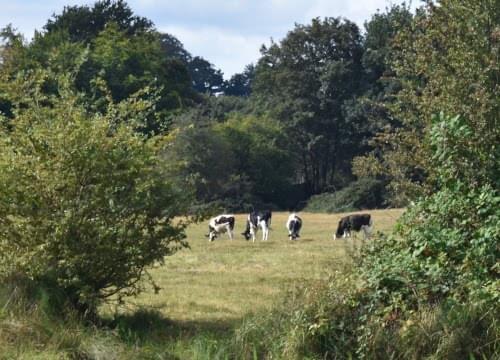
I think you will all agree that the cattle have done an amazing job this year, but soon they will leaving us, and I for one will miss them! It is vitally important that they graze the Green and stop the grasses from becoming too dominant and smothering the wildflowers. The dung is also important for fertilizing the soil as well as supporting a range of fungi and insects - in fact I have just come across a 159 page book entitled Insects of the British Cow Dung Community ......anybody interested?!
August 2021
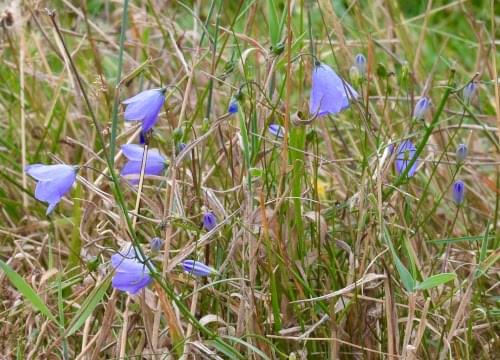
Well, there is certainly an Autumnal feel to the Green - the blackberries are ripening and the hawthorn berries are starting to turn. Another indicator that summer is coming to an end is the appearance of the delicate harebell, which flowers from July through to September. It is an important source of nectar for insects during the Autumn and it only grows on the dry side of the Green. There is a lot of folklore surrounding these plants, including that fairies live amongst the flowers and will cast a spell on anyone walking through them - so walk past them at your peril!
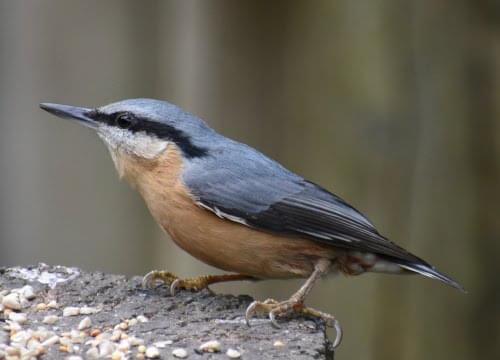
A bird that can often be heard and seen on the Green is the rather lovely nuthatch. They usually frequent the mature trees on the Maple Hayes boundary and in spring will often nest in holes in those trees. Admittedly, I didn’t take this photo on the Green, but rather yesterday at RSPB Middleton Lakes (well worth a visit!). But I thought it worthwhile to share this photo and I am sure you will agree, they are gorgeous birds and one to look out for on the Green.
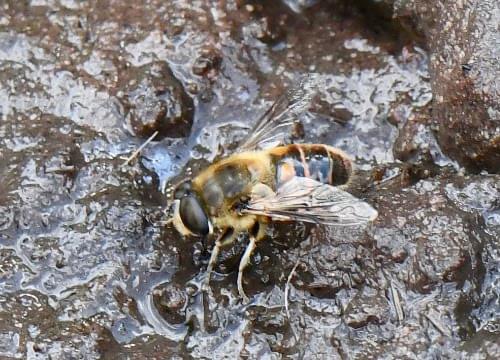
Now, I know this is not going to appeal to everyone, but I noticed a number of insects sitting on the mud near the pipe. Whilst they look like male honey bees, a closer inspection and a search in my guidebook revealed them to be the dronefly (Eristalis tenax). They lay their eggs in mud/damp/rotting material and this is what I think they are doing in the photo!
Just to remind you that we are having a work party this Sunday (5th September), from 9.30 - 11.30. We will meet by the pipe and will be working mainly on the wet side of the Green removing the stands of willow herb. So please wear suitable footwear and personally I would wear trousers, as the horseflies are still around! Gloves are advised. The willow herb can be pulled by hand, but I will bring scythes along as well.
July 2021
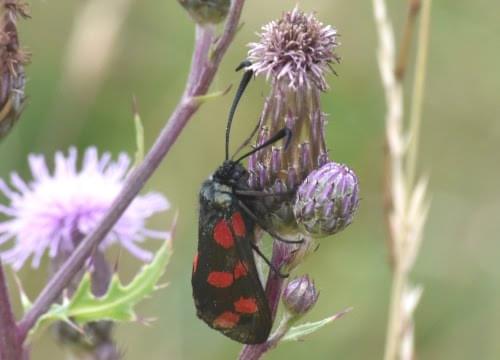
How about this for a stunning find? This is not a butterfly, but actually a moth that flies in the daytime. It is a six-spot burnet, so called because it has six bright red spots on each of its wings! The red spots, whilst looking really smart, actually indicate to predators that the moth is poisonous, as they can release hydrogen cyanide if they are attacked. I am not sure if the cyanide kills the predators, but you can see why they would leave the burnet moth well alone!
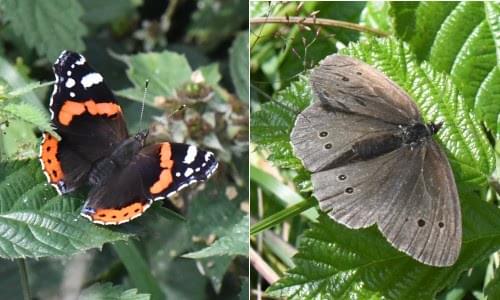 There are so many butterflies about at the moment and they can easily be seen along the boundary edge of the Green (especially on the bramble and thistle) as well as on the damper side of the Green. They are very active at the moment, which means taking photos of them is quite a challenge! However a red admiral (LHS) and a gorgeous chocolate brown ringlet butterfly (RHS) cooperatively sat still for more than 10 seconds whilst having their photo taken!
There are so many butterflies about at the moment and they can easily be seen along the boundary edge of the Green (especially on the bramble and thistle) as well as on the damper side of the Green. They are very active at the moment, which means taking photos of them is quite a challenge! However a red admiral (LHS) and a gorgeous chocolate brown ringlet butterfly (RHS) cooperatively sat still for more than 10 seconds whilst having their photo taken!
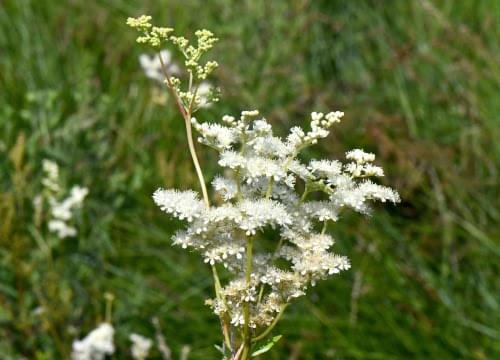
If you look across to the wet side of the Green, you should see some swathes of creamy white flowers, which belong to the the meadowsweet plant. These frothy flowers have a sweet flavour (seemingly you can make a cordial with them) and the plant has been used for centuries by herbalists, including for treatment of digestive conditions. Quite a useful plant to have about!
June 2021
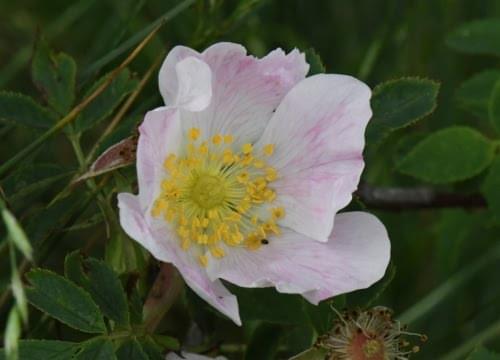
Whilst the orchids are putting on a good display, there are a lot of other, less showy plants that are also looking lovely at the moment. Not least is the humble dog rose, which twines it way up through some of the trees and bushes and has an exceedingly delicate pinkish flower. Well, I say dog rose, but after looking in my trusty Collins Flower Guide, I realise that there are a number of "dog roses", which require a careful examination in order to distinguish between them! Apart from been loved by insects for their nectar, dog roses also produce the wonderful bright red hips in the Autumn, which are enjoyed by the birds and anybody who is intent on making rose hip syrup!
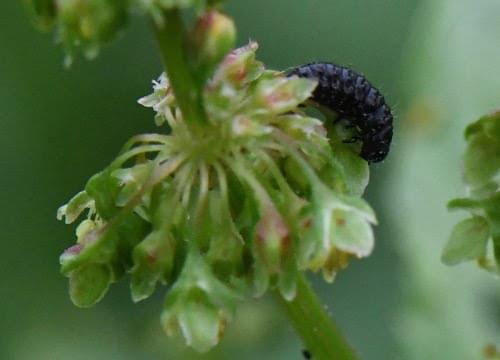
Just to show that the Green supports a whole range of invertebrate life, I managed to find this small (about 0.5cm long) caterpillar-like thing, on some of the dock. Initially I thought it was ladybird larvae, but a closer examination, and a bit of research lead me to the conclusion that it is the larvae of the green dock beetle. The adult beetles can be seen on the dock leaves and as the name sugests, are a rather smart metallic green colour.
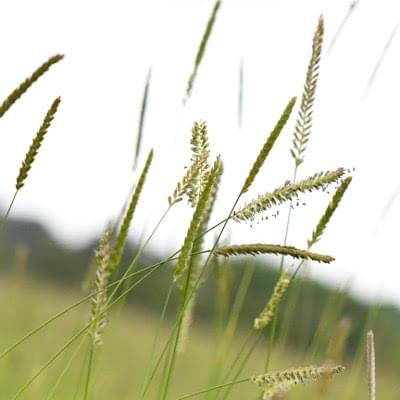
Anyone who suffers from hayfever, will be well aware that the grasses are flowering at the moment and producing rather a lot of pollen. We have a total of 16 different types of grass growing on the Green and one of my favourites has to be Crested Dog's Tail. It is one of the easier grasses to identify, having a distinct spiked appearance. In the photo the small dark spidery bits that you can see hanging down, are in fact the anthers of the flower and yes, releasing lots of pollen!
May 2021
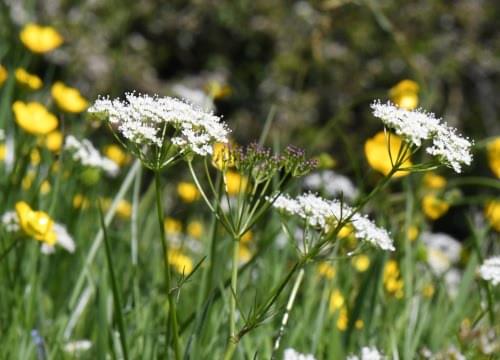
With the warmer and wetter weather arriving towards the end of the month, the grass and buttercups and everything else has suddenly put on a huge growth spurt! The hawthorn blossom is out, the birds are singing and the cold days of winter seem a long time ago. One of the plants putting on a good display is the white pignut, whose delicate flower looks lovely amongst the buttercups.
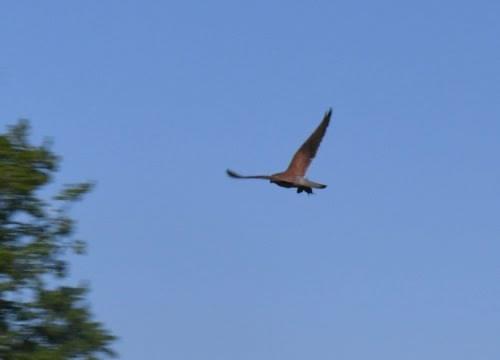
And now for something a bit more dramatic….! I was watching a kestrel hovering over the Green, when it suddenly dived into the rushes and came out holding on to a vole! I managed (just) to get a photo as it flew away and you can see the vole hanging down in the kestrel’s claws. It is most likely a field vole as they are the most common type of vole and if you look closely, it also has a short tail (characteristic of a field vole). It is great to see the kestrels successfully hunting and hopefully they have a nest nearby.
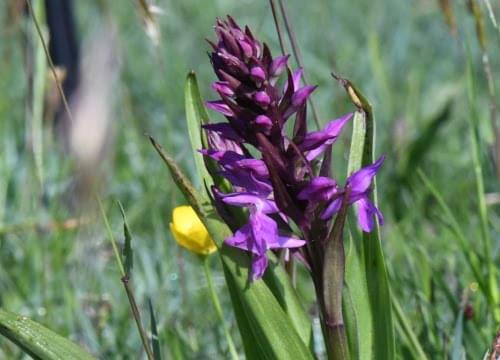
The good news is that the orchids are just starting to flower! There seem to be quite a few growing, so hopefully we will have a good show over the next few weeks. We will be putting up the cattle-proof fencing in the next week or so and the cattle will be turned out shortly after that.
April 2021
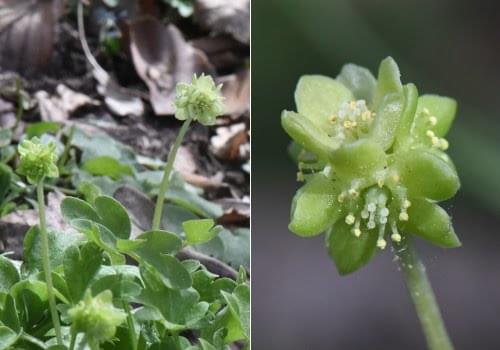
It is always exciting to find something new on the Green, and this happened to me a few days ago, when I came across this rather small plant with its delicate greenish flowers. It is known as Moschatel or Townhall Clock and whilst I had read about it, I had never seen any. It is called Townhall Clock as the flower head has a cluster of five flowers: four of which face outwards at 90 degrees to each other (like the clock faces of a town hall clock) and then there is another flower which faces upwards! How weird is that?! It likes to grow in shady conditions, so can be found on the damper edges of the Green.
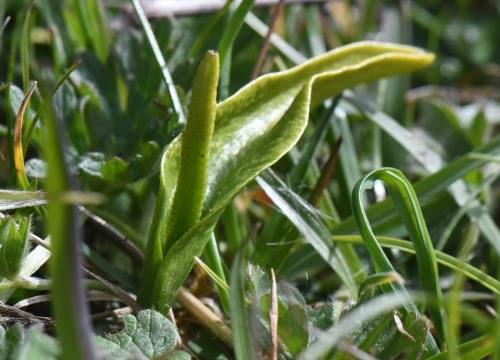 The adder tongue fern is also starting to appear, which is great news! This small green fern is very difficult to see amongst the grass, but it is a very important plant for the Green as it is quite rare and is indicative of ancient meadowland. It is called an adder tongue fern as the spike (which contains the spores) is supposed to look like a snake’s tongue - you might need a bit of imagination on that one!
The adder tongue fern is also starting to appear, which is great news! This small green fern is very difficult to see amongst the grass, but it is a very important plant for the Green as it is quite rare and is indicative of ancient meadowland. It is called an adder tongue fern as the spike (which contains the spores) is supposed to look like a snake’s tongue - you might need a bit of imagination on that one!
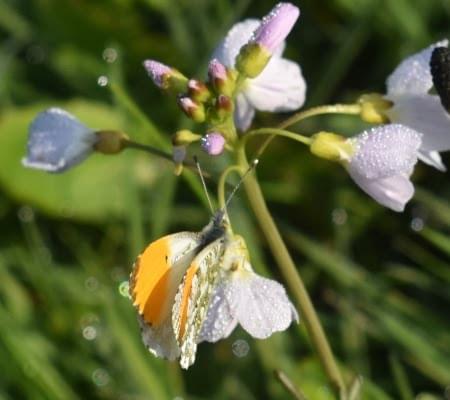
On some of the sunny days that we have been having, some butterflies can be seen flitting about. So far I have seen peacock, small tortoiseshell, brimstone and the lovely orange tip. The orange tip feeds and lays its eggs on the lady’s smock, that grows on the wet side of the Green and which is now starting to flower. So there should be a lot more orange tips flying about in May and so do keep an eye out for them.
March 2021
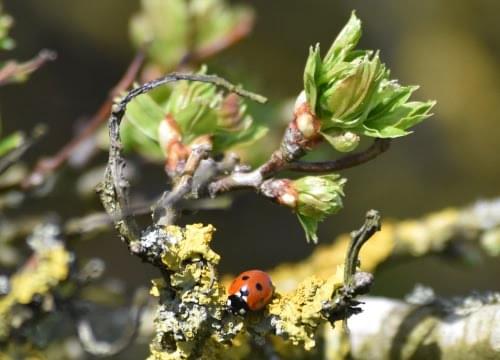
What a glorious end to March and Spring is definitely on the way! The birds are singing loudly and I even heard my first chiffchaff this week! (Chiffchaffs are summer visitors and are one of the first warblers to return to the UK.) Apart from the birds, the leaves of the hawthorn have suddenly started to emerge and are giving the edges of the Green a lovely fresh greenish haze. I was lucky enough to see a bright ladybird amongst the newly emerging hawthorn shoots!
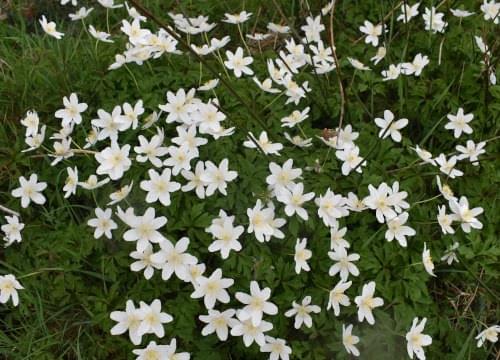
Whilst the yellow lesser celandine has been flowering for most of March, in the last week, the gorgeous wood anemone (or wind flower) has started to produce its delicate white flowers. This has to be one of my favourite plants, so look out for more pictures of these over the coming weeks, as there will be many more!
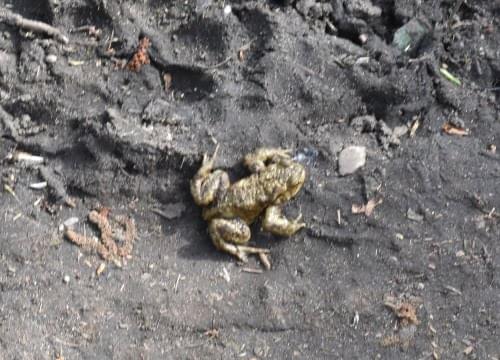
Something that you don’t often see, is a toad on the path by the back gate! Having narrowly avoided standing on it, I then noticed on the other side of the path, two more toads. These were in a more rather amorous position, but they were also a bit more camera shy and headed off into the undergrowth! Great to know they are about and do be careful not to stand on them if you are walking near the back gate!
February 2021
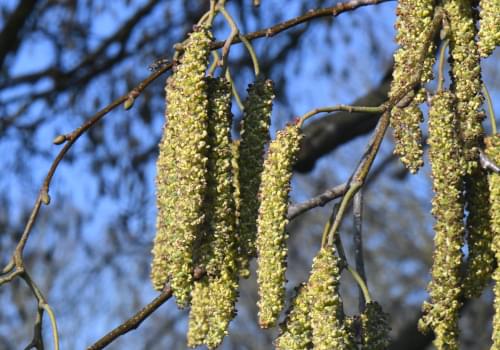
After a freezing cold start to February, the end of the month was a lot more pleasant, with a definite feel spring in the air! The birds are singing, the crocuses are flowering and the bluebells are pushing their way through in Leomansley Woods; I am sure everyone is feeling a lot better for it. The trees are also doing their bit and the alder are putting on a lovely display of catkins, which take on a golden hue in the sun!
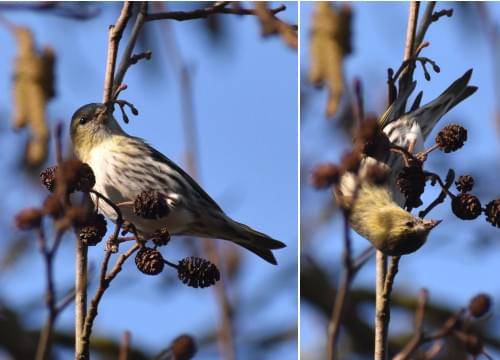
Whilst walking past the alder trees by the football field car park, there was a lot of small birds twittering and flitting about in the trees. A closer inspection revealed that this was a flock of siskins. These are delightful small yellow green finches, with a streaky chest and a distinctive forked tail. They love the alder seed and feed on them… but often from an upside down position! Seemingly this enables them to access more of the seed which other, heavier finches, can’t reach. Makes sense..!
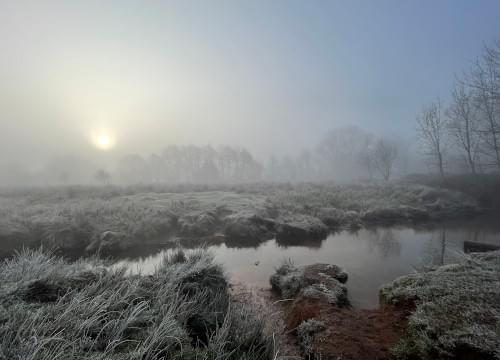
Image courtesy of Wildlife Kate
Finally, a very atmospheric misty early morning shot from Wildlife Kate, looking across Leomansley Brook. I love the way the sun is just trying to pierce through the mist. Definitely worth getting up for!
January 2021

After most of January being rather wet and miserable, it was lovely to have some snow and a bit of sunshine last week. What a glorious day to go over to the Green and take some photos! One of my favourite shots is this wintery scene looking back across the green to the cathedral. I never bore of this view, and it was lovely to see it with its winter hat on!
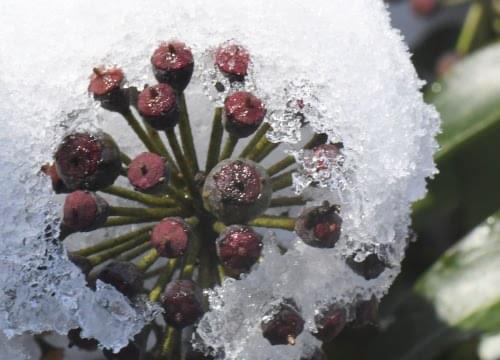
Ivy berries surrounded by some snow and ice! Anyone who watched Winterwatch last week, may remember Chris Packham and Megan McCubbin talk about the amazing nutritional value of these berries. Now, ivy flowers in September and then produces these dark brown berries, which, whilst they are not as obvious to see in the hedgerow as the more colourful hawthorn and rowan berries, they nevertheless pack a punch; they have a high fat content and contain as much energy per gram as a chocolate bar! It is no wonder that they are an important food source for blackbirds and thrushes at this time of year, when food can be scarce.
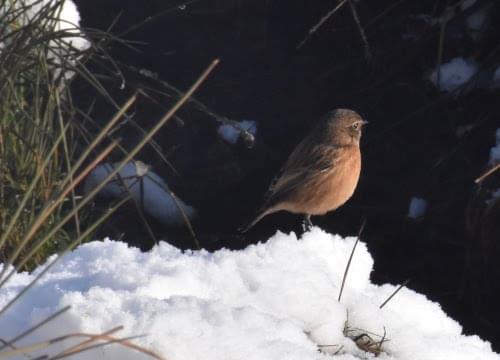
Whilst standing by the brook, I managed to see a lovely pair of stonechat, hopping in and out of the rushes. Whilst these are commonly seen on the heathland at Cannock Chase, they are a rare visitor to Pipe Green. They may be just visiting for food, or maybe they might decide to breed this year - we will have to wait and see! The male is starting to get his breeding plumage, but the female (shown here) is also looking gorgeous and was much more obliging in having her photo taken! I love the way the sun is lighting up her feathers on her chest.